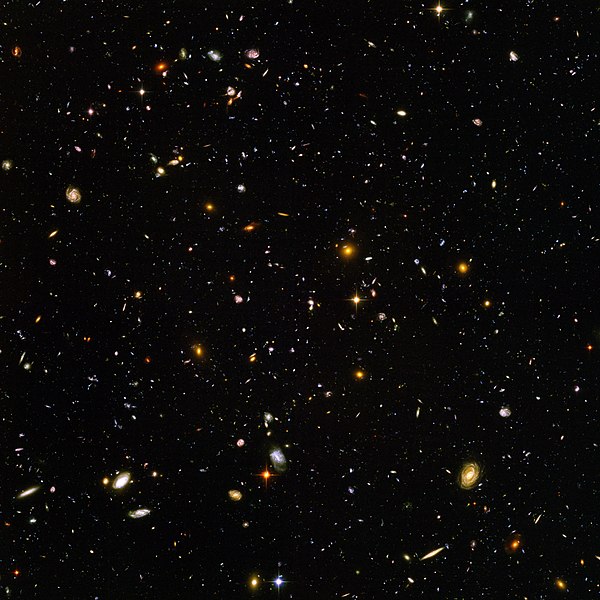Carl Sagan got me thinking (as he usually does).
I wanted to know just how many stars there are in the universe. This is almost impossible to figure out, as we can see only so far away. One of the more impressive images ever taken by humans is what's called the Hubble Ultra Deep Field::

This is a composite of many hours of exposures of a small part of the sky that isn't too crowded with nearby stars. That way the Hubble telescope could really expose for the darkest regions of that space without nearby light pollution clouding up the image.
So NASA counted around 10,000 galaxies in that picture. *Only* 10,000. The thing is, the Hubble Ultra Deep Field captures only 1/13-millionth of the entire sky around earth (this includes both hemispheres). Whoa. So the novice astronomer in me did the math.
10,000 galaxies on average x 13,000,000 bits of sky = around 130 BILLION galaxies in the observable universe.
Holy crap. This is of course a very rough calculation, because this is only takes into account the observable universe. The 'actual' number of galaxies could be many times more, depending on the actual size of the universe (if it has a limit).
So... with 130 BILLION galaxies out there, I calculated how many stars exist in the observable universe. On average, a typical spiral-arm galaxy like our own Milky Way (and the nearby Andromeda) contains around 100-400 BILLION stars. Whoa. Let's plug the bigger number into our equation.
130 BILLION galaxies x 400 BILLION stars each = around 52,000,000,000,000,000,000,000 stars.
That's 52 sextillion stars in the entire universe.
That's very difficult to grasp. We're familiar with millions (my uncle is a millionaire). And billions (there are 6 billion people in the world). And perhaps even trillions (the US is $11 trillion in debt right now). People get lost with anything adding up to quadrillion. Or quintillion.
So 52 SEXTILLION stars???
It's inconceivable.
I searched the internet to see if astronomers actually did a more accurate study of how many stars there are in the observable universe. And it looks like they did, in 2003. They came up with 70 sextillion stars within range of modern telescopes (I was in the right -illions range, so I win!)
Thing is, it's almost silly to 1) grasp at the quantity of 70 sextillion, and 2) consider even that a 'rough estimate'. Galaxies are so far away that they appear as mere blobs of light when seen through telescopes on Earth (you only get the crisp images with individual star details when you take very long exposures, to let the light burn in).
Plus, some recent surveys suggest that our Milky Way may contain many more stars than previously observed, to the tune of 3 TRILLION stars. Or about 500 stars per person on earth.
It's humbling to realize that the universe is perhaps too large even for the human brain to quantify. You start thinking about distances, and it liquefies any reasonable sense of grasping the size of our universe.
For example, the Milky Way is roughly 100,000 LIGHT YEARS in diameter. That's about 580 quadrillion miles across. Or, if you drove 80 miles per hour in your car, a road trip across the Milky Way would take you about 827 billion years to drive across it, not counting stopping for gas.
What are the chances of life only occurring on Earth? It's inevitable that conditions for life has already occurred on a planet peacefully revolving around at least a handful of those 70 sextillion stars, giving many billions of years of (theoretical) existence here in the universe. Is it all beyond human comprehension?
The questions pile up.


No comments:
Post a Comment